The discussion took place after the exhibition "field verb" by the artist fansy in sesame space. As the architect/artist Iris Lacoudre prepared her final presentation of the IFP residency project "public place", we also invited curator li shan Alessandro Rolandi to join the two artists.
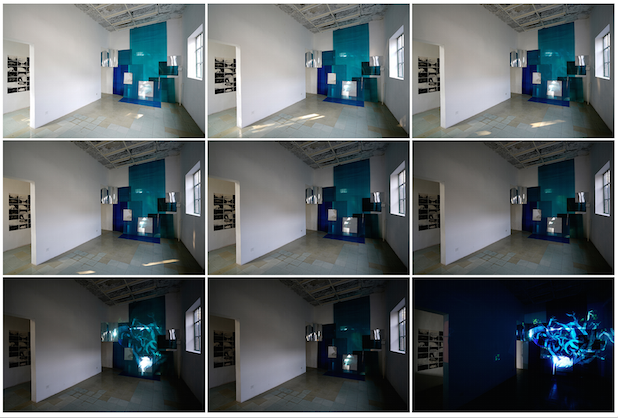
Dai Xiyun: Even though there was no expected
sunset on the opening day, the rainy weather created an interesting and
different atmosphere. What do you think of the relationship between your works
and the surrounding environment?
Fan Xi: I regarded the whole space as moving
images. The relationship between people and space, matter (material) and images
is dynamic and constantly changing, appearing and subsiding. Therefore, all
images are produced through moves, created by interventions from visitors and
material in the space. Simultaneously, the work as a whole forms a visual
transformation of daily-life material via interventions of time (materialized
by light). I see these interventions as a process of image-making. It is an
intact but insufficient experience, as well as a test full of uncertain
testabilities. The sunrise and the sunset are special moments of time
variation; they are also clear observable nodes of visual alterations.
Therefore, we scheduled the opening time to be consonant with the sunset.
Although it was raining, it was quite lucky that the wet weather added another
layer to the “scene”.
Dai Xiyun: So are the space, image, and
environment factors affecting “the scene” ? Does “the scene” mean a field that
bears these dynamic relations? How did you come up with the exhibition title
The Scene, Being? Does “being” here relate to your previous project All Beings?
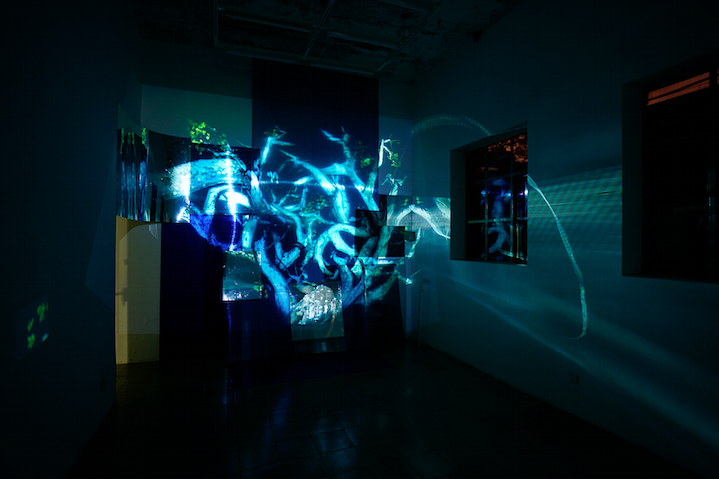
A SENCE BEING exhibition site Fan Xi
Fan Xi: I would say this title is a bit
neutral, simple and has no advanced guidance. It leaves more space to the
exhibition site, and the site could be spontaneous and temporal. I hope the
site would be full of invisible and recessive forces. Besides meaning a field,
the “scene” also means a series of moving images, in which visitors’ actions
keep shaping these visible or invisible relationships. Visitors’ engagements
with material and spatial environment are maintained in this “scene”. I use
“being” instead of literal “verb” in order to emphasize the internal and
external performativities—I call them dynamics. In most of my previous
projects, I used only the image itself to play with these recessive
relationships. But for this time, I’d like to cast aside the pressure of making
a proper work for an exhibition, rather, I hope to simply capture the state
that constantly moves, to hint at those recessive relationships, each day
(based on light changes) as a cycle. All Beings is about sharing and
synchronization in dynamic temporalities and environments. You can observe in
the works that I use unstable flashlight to intensify details of daily life and
actually they are things that we normally won’t give a glimpse. These details
are always present and their vitality can be liberalized by doing so. The
“scene” here is a kind of state, it could be casual, intimate, intense, joyful,
subtle or dull; could be real or imaginative; being divisive or alienated at a
certain point.
Dai Xiyun: It was a busy and rainy night when
Alessandro visited the exhibition, while Iris later waited alone in the
exhibition space from sunny daytime to the sunset. Could you share your
different impressions with us?
Alessandro Rolandi: I think the installation in
the first room worked very well. Instead of thinking about the work
itself—images of different trees digitally pieced together forming an image of
a giant tree, projected on layers of various materials—I enjoy the openness of
the space, the moist weather and how the artwork works with the weather. Its
existence becomes part of the environment—a cloudy and rainy evening. It also
reminds me "romantic" and "symbolistic" atmosphere. Of
course, here I do not mean the literal or cheesy understanding of the two
words, but the traditional art historical concepts. The fact that it is not a
real tree but a “candlelight” modernizes it, a contemporary “spleen”. Nature
has been digitalized. Doors and windows of the seemingly abandoned building
open all night, people can enter and spend or consume some melancholic or
intimate time. I can link the experience to Baudelaire, Keats, Hubert Robert,
the British Graveyard poetry and the French symbolists. These are some western
references and specifically from my own subjective reading about the work, yet
it was what I genuinely sensed there. Perhaps the photographs in the corridors
could not be appreciated enough in this setting, but with the lights, they are
also interesting.
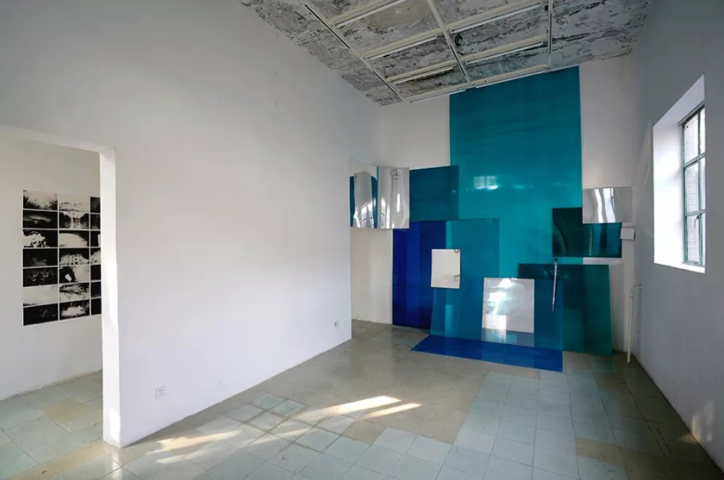
A SENCE BEING exhibition site Fan Xi
Dai Xiyun: In my impression, your setting
possesses the whole field with a rhythm of shattering and re-converging. For
instance, in the space at the front where images of the tree are projected onto
construction boards and reflective mirrors, the refracted and reflected light
creates multiple layers, and is scattered about in the space, occupying and
even overflowing the exhibition space in a lithe way. The warm light shone
through neighbors’ frosted glass also becomes a part of the “scene”. However,
in the narrow space at the back, dozens of black and white photos are assembled
to form a shadowy block under the dim light. Seemingly, this dark corner takes
in and swallows all active light in the front space. Light connects two
separate spaces, while they confront one another with their weights.
Fan Xi: Maybe when we look at the form of the
work as a whole, images, light, and materials vary a lot in the front space,
creating a spatial experience extended out of 2D planes. But in the space
behind, there is only a set of photos, which seems to go back to two dimensions
again. I consider more on how these elements function as a whole, and focus
more on the process of transformation: at night, light will make a spatial
arrangement out of the photos in the narrow corridor and the construction
materials in the front space. It is all about alterations, or you can say it is
a reminder, a reminder of temporality. In a broader sense, the exhibition is
also a part of the temporal flow. When one moves out from the exhibition site,
the exhibition will be diluted, blurred, and then becomes uncertain after
clashing with the next experience or things. It may become an encounter that
nothing happens. But such changes that follow are very consistent, just like
our life experience.
Iris Lacoudre: Reflecting on my own experience
of the exhibition, I am quite intrigued by the relation between light and
material. I really like the light reflecting out of the exhibition space, it
intrigued me and attracted me in. As well as the outdoor light that you bring
into the narrow interior space behind. It reminds me the street light streams
through windows. I am also very interested in the material you use for this set
of installation, the kind of blue plastic construction material. Why did you
think of using this specific material?
Fan Xi: I studied sculpture in art academy,
therefore I often went to building materials markets. In the beginning, I was
just looking for a kind of material that obstructs projected images, but should
also be common and functional. It’s better to have various possibilities on
form, plasticity, color, and plane, and also can be used to build and form
space. All these specialties will elicit many imaginations, at least for me.
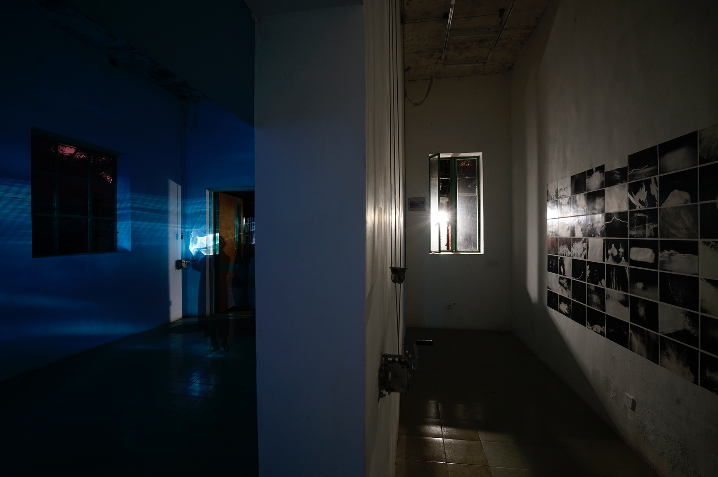
A SENCE BEING exhibition site Fan Xi
Dai Xiyun: I remember that when you visited the
yard for the first time, you wandered in the courtyard for quite a long time,
made many sketches. Why did you give up the idea of using the outdoor
courtyard, but only use the exhibition space?
Fan Xi: To make it more concentrated. The work
now has already extended its content out into the courtyard. The mirrors
reflect the content of the work and the indoor light onto the outdoor windows
and walls. The idea of setting something outside now seems too deliberate. I’m
satisfied with this decision, it’s more natural. Light is always there—the
sunshine in the daytime, and the lamplight that diffuses from the space into
the courtyard at night. It should just be a reminder, and easy to find out when
you are in the yard. This reminder doesn’t need to be emphasized, as it will
disappear when doing so. I feel it has a much more comfortable relation
now.
Iris Lacoudre: Have you ever thought about
materializing this work at a construction site where the materials are broadly
used? Where these materials are very common? It could be another way to look at
them.
Fan Xi: This project is developed mainly around
the changes of time, the starting and ending points are not of the material. So
I only picked up their inherent properties of obstruction and reflection, and
didn’t intervene more to stretch the possibilities of such material. I guess I
won’t try the project at a construction site as you mentioned. For me it will
lose something, it also involves a risk to be destroyed, or will intervene the
original order of the context. Perhaps I will try more outdoor possibilities in
the future, in some public space like a parking lot.
Dai Xiyun: Iris’ presentation at IFP, the
Common Places, is also about using materials to intervene and change the
dynamic relationship between people and space, but she explores this idea in
her own artistic language as an architect. In contrast to the “romantic” and
abstract "scene" Fan Xi created, Iris's involvement with space has a
more socially-engaged meaning, more like an observer. Iris's "scene"
is a place, and space for the other.
Fan Xi: Maybe she emphasizes more on physical
perception. I have the opposite approach. I turn from the physical perception
to abstraction, and then realize the abstraction in a concrete space.
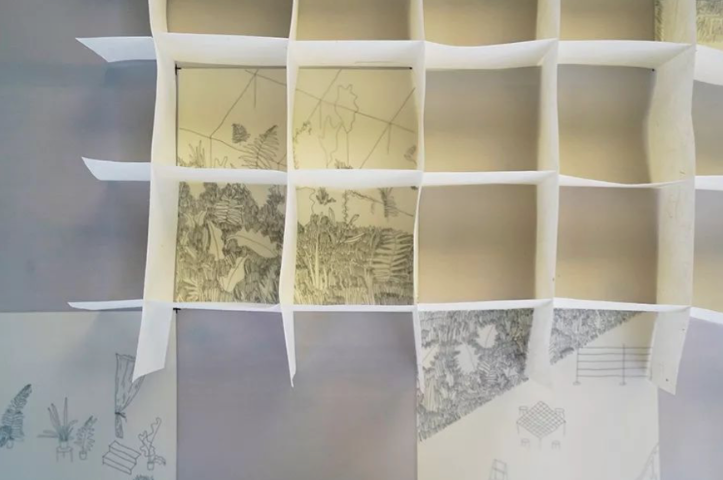
Iris Lacoudre exhibition site
Iris Lacoudre: Daily materials and daily
objects. What I like about your exhibition is the way you use common materials
that we see everyday, somehow as tiny monuments that we ignore if we don’t pay
attention. Regarding the exhibition I am preparing in the actual “common place”
of IFP Studio, the space itself actually creates collisions: it is not a white
box, and the structure of the architecture itself is very present. It (the
site-specific installation) will be something made with paper, the tracing
paper that we use for architectural drawings. It will be a quite “light”
intervention in the space, using paper in its multiple forms, from newspaper,
to models, drawings and tracing paper. I was vacillating whether I should
extend the paper installation into the courtyard, or just keep it in the studio
space, as the common place of the hutong is actually the courtyard. Your explanation
of why you didn’t set up things outdoor has helped me find my answer. These are
the photos I took during my residency here, which are some ordinary corners
around the hutong area. I call them “tiny monuments” and made a newspaper from
this inquiry, as a daily object.
Fan Xi: I also make booklets, as images have
another dimensional order on paper, the editing process is a bit like
rebuilding a “space”. In the newspaper, you enlarge some of the daily-life
corners, they visually occupy and manipulate, creating a visual and
psychological common space. The material transformation from a physical space
to a visual plane is also very interesting. I also like the models in your
studio that are made of felt-like paper, an unforced and natural material. I only
knew after your introduction that they are based on houses in hutongs, and you
transform them into paper-made imaginary space. They look like accessible
space, a 3D map. In fact, people seem to be able to walk through, but
everywhere is also blocked and limited, a bit like the traffic system in your
newspaper.
Iris Lacoudre: This series of small paper
models comes from the intention to work with "accidental spaces", as
unexpected and uncontrollable spaces. These models distort, adapt, and disturb
a given system, an existing structure structure. They invite to think architecture
as an open structure, a common ground on which accidents could happen.
I like what you mentioned about scale, about
feelings of the materials.
Alessandro Rolandi: Your "accidental
spaces" remind me of Aldo van Eyck, a Dutch architect, who designed playgrounds
for children in small public spaces in the city, with very simple geometric
shapes, even as minimal as a few curved lines, but offer great joy to children.
Fan Xi: You use a very systematic approach to
represent irregular buildings, it’s a bit like an "accident." Imagine
if these "accidental spaces" can be materialized and achieved, they
will have a sense of losing control, and the relationship between people and
building will be more complicated. I have already started imagining the
situation that people live in this runaway space.
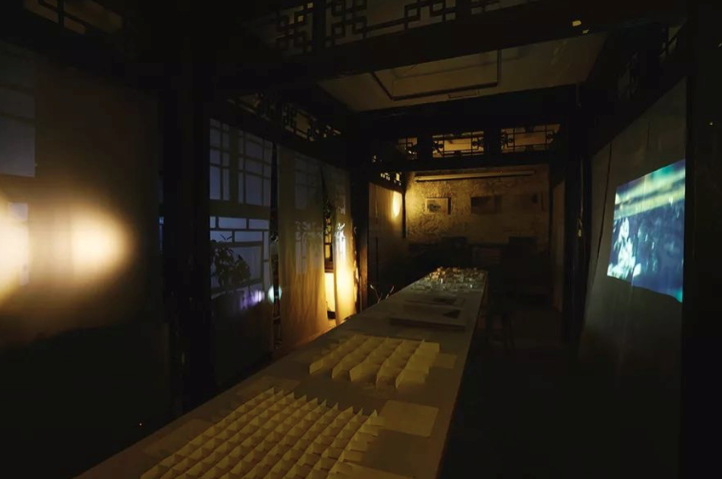
Iris Lacoudre exhibition site
Photos by Sun Shi
Fan Xi
Artist, living and working in Beijing. She
graduated from the Sculpture Department of Central Academy of Fine Art
(Beijing). Her practices mainly develop out of images. Through editing images
and materials, she realizes the abstract concepts in concrete space, and
considers people as the most important part adding to the missing pieces of the
integrated scene.
Dai Xiyun
IFP collective member. She studied exhibition design at the Central Academy of Fine Arts (CAFA) and holds a MA in fine art from Dutch Art Institute (DAI). From 2017. She develops her art practices through writing, performance and curating.
Iris Lacoudre
Architect, living and working between Paris and
Stockholm. She studied at the School of Architecture of Marne-La-Vallée, TU in
Berlin and Konstfack in Stockholm. She has been working in different
architecture practices, in Berlin (LIN), Tokyo (Atelier Bow Wow), Stockholm
(Arrhov Frick), Paris (Bruther). Working across fields, her practice is
questioning how we live in a given environment, looking at domestic behaviors.
As a nomadic practice, her work inhabits the place in which she works and
lives, with which she starts a conversation.
Alessandro Rolandi
Born in Pavia; living and working in Beijing
since 2003. Studied Chemistry, Experimental Theatre and film-making, History of
Art. He has been living and working in Beijing since 2003, as a multimedia and
performance artist, director, curator, researcher, writer and lecturer. His
work focuses on social intervention and relational dynamics to expand the
notion of art practice beyond existing structures, spaces and hierarchies and
engage directly with reality in multiple ways. He is the founder, in 2011, and
director of the Social Sensibility Research & Development Department at
Bernard Controls in Beijing and Paris and one of the founding partners of the
Social Sensibility Research Institute (SoSense).
